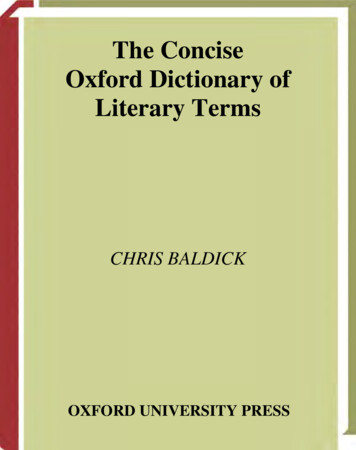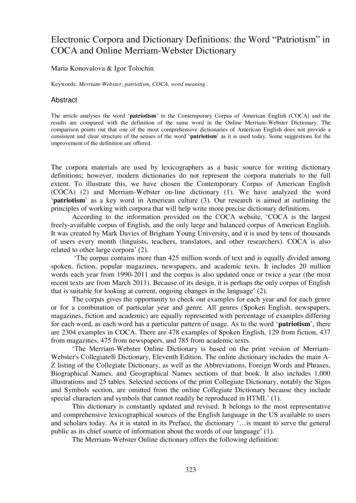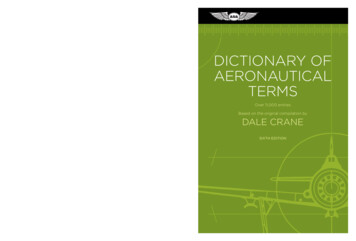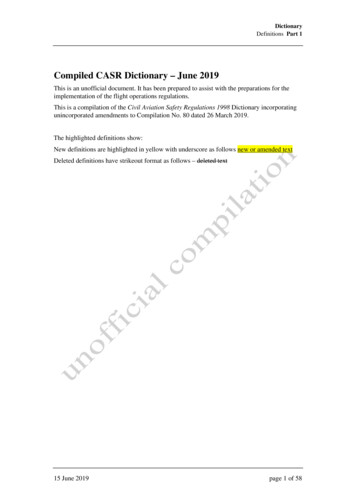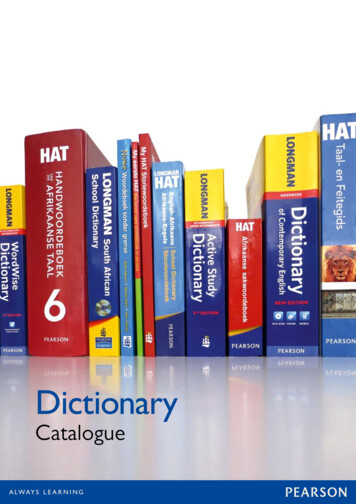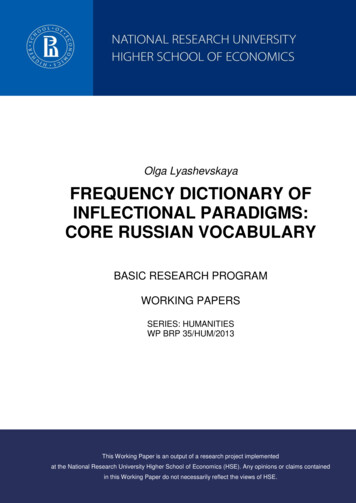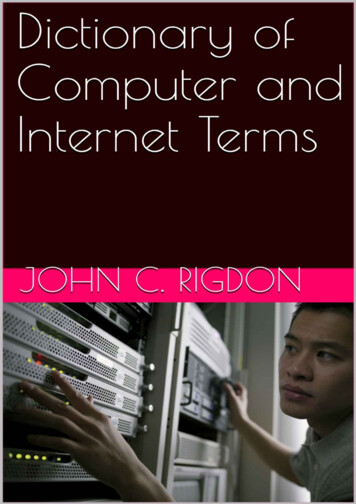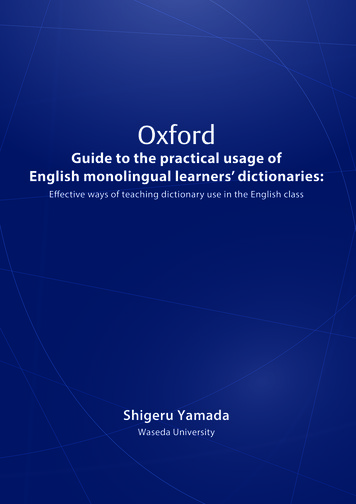
Transcription
The Routledge Dictionary ofLiterary TermsThe Routledge Dictionary of Literary Terms is a twenty-first century update of RogerFowler’s seminal Dictionary of Modern Critical Terms. Bringing together originalentries written by such celebrated theorists as Terry Eagleton and Malcolm Bradburywith new definitions of current terms and controversies, this is the essential referencebook for students of literature at all levels.This book includes: New definitions of contemporary critical issues such as ‘Cybercriticism’ and‘Globalization’.An exhaustive range of entries, covering numerous aspects to such topics as genre,form, cultural theory and literary technique.Complete coverage of traditional and radical approaches to the study and productionof literature.Thorough accounts of critical terminology and analyses of key academic debates.Full cross-referencing throughout and suggestions for further reading.Peter Childs is Professor of Modern English Literature at the University ofGloucestershire. His recent publications include Modernism (Routledge, 2000) andContemporary Novelists: British Fiction Since 1970 (Palgrave, 2004).Roger Fowler (1939–99), the distinguished and long-serving Professor of English andLinguistics at the University of East Anglia, was the editor of the original Dictionaryof Modern Critical Terms (Routledge, 1973, 1987).
Also available from RoutledgePoetry: The BasicsJeffrey Wainwright0–415–28764–2Shakespeare: The BasicsSean McEvoy0–415–21289–8Literary Theory: The BasicsHans Bertens0–415–18664–1Contemporary British NovelistsNick Rennison0–415–21709–1The Routledge Companion toPostmodernism (Second Edition)Edited by Stuart Sim0–415–33359–8The Routledge Companion to RussianLiteratureEdited by Neil Cornwell0–415–23366–6Who’s Who in ContemporaryWomen’s WritingEdited byJane Eldridge Miller0–415–15981–4Who’s Who in Lesbian andGay WritingGabriele Griffin0–415–15984–9Who’s Who in DickensDonald Hawes0–415–26029–9Who’s Who in ShakespearePeter Quennell andHamish Johnson0–415–26035–3Who’s Who in Twentieth-CenturyWorld PoetryEdited by Mark Willhardtand Alan Michael Parker0–415–16356–0
The Routledge Dictionaryof Literary TermsPeter ChildsandRoger FowlerBased onA Dictionary ofModern Critical Terms,edited by Roger Fowler
First published in 1973 as A Dictionary of Modern Critical TermsRevised edition published in 1987by Routledge & Kegan Paul LtdThis edition published 2006by Routledge2 Park Square, Milton Park, Abingdon, Oxon OX14 4RNSimultaneously published in the USA and Canadaby Routledge270 Madison Ave, New York, NY 10016Routledge is an imprint of the Taylor & Francis Group Routledge 1973, 1987, 2006This edition published in the Taylor & Francis e-Library, 2006.“To purchase your own copy of this or any of Taylor & Francis or Routledge’scollection of thousands of eBooks please go to www.eBookstore.tandf.co.uk.”All rights reserved. No part of this book may be reprinted orreproduced or utilised in any form or by any electronic,mechanical, or other means, now known or hereafter invented,including photocopying and recording, or in any informationstorage or retrieval system, without permission in writingfrom the publishers.British Library Cataloguing in Publication DataA catalogue record for this book is availablefrom the British LibraryLibrary of Congress Cataloging in Publication DataThe Routledge dictionary of literary terms / [edited by]Peter Childs and Roger Fowler.p. cm.‘Based on A Dictionary of Modern Critical Terms, edited byRoger Fowler.’ Rev. ed. of: A dictionary of modern critical terms.Rev. and enl. ed. 1987.Includes bibliographical references.1. Literature – Terminology. 2. English language – Terms andphrases. 3. Literary form – Terminology. 4. Criticism – Terminology.I. Childs, Peter. II. Fowler, Roger. III. Dictionary of moderncritical terms.PN41.D4794 2005803–dc22ISBN 0–415–36117–6 (hbk)ISBN 0–415–34017–9 (pbk)2005006915
To Claire Philpott, with thanks
ContentsNote on the style of referencesList of termsDictionary of literary termsNotes on contributorsviiiix1254
Note on the styleof referencesCross-references give the article to which the reader is referred in SMALL CAPITALS.Further reading is suggested wherever appropriate, sometimes within the text andsometimes at the end of articles, whichever is stylistically more suitable. Dates of firsteditions are given when they are significant, but usually the most accessible andconvenient modern reprintings and translations are cited.
List of termsAbsurdAction, actorAestheticismAestheticsAffective fallacyAktualisaceAlienation sAnticlimaxAnti-heroApocalyptic otelian Cento(nism)CharacterChicago y of mannersComparative literatureCompetence, literaryComplaintConceitConcrete letCreationCriticismCritiqueCultural criticismCultural 52
x List of termsDénouementDeviationDialogic eDisbeliefDiscourseDisseminationDissociation of sensibilityDocumentaryDominantDouble ironyDramaDramatic icEpic theatreEpistleEssayEssentialismEthical cyFantasticFarceFeelingFeminist 828282848585889090ForegroundingFormFormalismFree verseGenderGenerative emonyHeresy of paraphraseHermeneuticsHeroHeroic coupletHistorical yperboleIdeologyIllocutionary actImageImaginationImagismImitationImplied authorIntentionInterior erary mode of 8128128129131132
List of terms xiMagical realismMannerismMannersMarxist imesisMirror Stage, eNarrative structureNarratologyNationalism and ethnicity classicismNeo-PlatonismNew criticismNovelObjective correlativeObscurityOdeOnomatopoeiaOral Other, theParadoxParaphraseParodyPastichePastoralPathetic uralismPoetic dictionPoetic licencePoeticsPoetryPoint of tmodernismPost-structuralismPractical logy and psychoanalysisQueer ningRepresentationResponseRevisionary 208209211212212
xiiList of termsScriptibleSemioticsSensibilitySexualityShort etSoundSpeechSpeech actStasisStoryStream of lternSubjectSurfictionSurrealismSuspension of slationsTravestyTypicalityUncanny, theUndecidabilityValueVariationVehicleVerbal ironyVerisimilitudeVers libreVerseVerse 49249250251252253
AAbsurd The theatre of the absurd wasa term, derived from Camus and popularized by Martin Esslin’s book The Theatreof the Absurd (1961), applied to a groupof dramatists whose work emerged duringthe early 1950s (though Beckett’s Waitingfor Godot and Ionesco’s The Bald PrimaDonna were actually written in the late1940s). In The Myth of Sisyphus (1942)Camus defined the absurd as the tensionwhich emerges from the individual’sdetermination to discover purpose andorder in a world which steadfastly refusesto evidence either. To writers like Ionescoand Beckett this paradox leaves humanactions, aspirations and emotions merelyironical. The redeeming message nolonger comes from God but is deliveredby a deaf mute to a collection of emptychairs (The Chairs, 1952); humanqualities, such as perseverance andcourage, no longer function except asderisory comments on the individual’simpotence (Happy Days, 1961); basicinstincts and responses, the motor forcesof the individual, become the source ofmisery (Act Without Words, 1957). Camushimself could see a limited transcendencein the ability to recognize and even exaltin the absurd (The Outsider, 1942) or inthe minimal consolation of stoicism(Cross Purpose, 1944). But he came tofeel that absurdity implied a world whichappeared to sanction Nazi brutality aseasily as it did individual acts of violence.From an examination of the nature ofabsurdity, therefore, he moved towardsliberal humanism: ‘The end of the movement of absurdity, of rebellion, etc. . . . iscompassion . . . that is to say, in the lastanalysis, love’. For writers like Beckettand Ionesco such a dialectical shift wassimply faith. For to the ‘absurd’ dramatistit is axiomatic that humans live in anentropic world in which communicationis impossible and illusion preferred toreality. The individual has no genuinescope for action (Hamm sits lame andblind in Endgame, 1958; Winnie is buriedto the neck in sand in Happy Days; theprotagonist of Ionesco’s The New Tenant(written 1953, produced 1957) is submerged beneath proliferating furniture);individuals are the victims of their metaphysical situation. Logically, the playsabandon linear plot, plausible characterdevelopment and rational language. Incontrast to Camus’s work their styledirectly reflects their subject.The term ‘absurd drama’, applied byEsslin to dramatists as diverse as Beckett,Ionesco, Adamov, Genet, Arrabal andSimpson, is something of a blunt weapon.Esslin had a disturbing if understandabletendency to trace the origins of theabsurd in an incredible array of writerssome of whom do not properly belong ina theatre which is convinced of theunbridgeable gulf between aspiration andfulfilment, the impossibility of communication or the futility of human relationships. In other words he is not alwayscompletely scrupulous in distinguishingbetween style and content. In his revisededition of his book, however, he hasshown a commendable desire to underlinethe deficiencies of a term which, whileproving a useful means of approachingdramatists intent on forging new drama,was never intended as a substitute for stringent analysis of the work of individualwriters.
2 ActionSee Martin Esslin, The Theatre of theAbsurd (2004); J. L. Styan, Modern Dramain Theory and Practice: Symbolism,Surrealism and the Absurd (1983).CWEBActionActorSee DRAMA.See DRAMA.Aestheticism A sensibility, a philosophy of life and of art, and an Englishliterary and artistic movement, culminating in the 1890s, with Oscar Wilde as itsmost extravagant exponent and WalterPater its acknowledged philosopher.Other names commonly associated arethose of the members of the PreRaphaelite Brotherhood, Swinburne,Arthur Symons, Ernest Dowson, LionelJohnson, Andrew Lang, William Sharp,John Addington Symonds and the earlyYeats. Aubrey Beardsley and J. McNeillWhistler are representative of the sametrend in the fine arts.For the Aesthete whose creed is to bederived from Pater’s conclusion to TheRenaissance (1873), reality amounts tosharp, fleeting impressions, images andsensations arrested by the creative individual from an experience in constantflux. The life of art, or the art of life,which the Aesthete wishes to equate, isideally a form of purified ecstasy thatflourishes only when removed from theroughness of the stereotyped world ofactuality and the orthodoxy of philosophical systems and fixed points of view. Thequest for unadulterated beauty is recommended as the finest occupation individuals can find for themselves during the‘indefinite reprieve’ from death whichtheir lives are. Pater’s phrase, ‘the love ofart for its own sake’, a version of theFrench l’art pour l’art, has served theAesthetes as a slogan, implying the repudiation of the ‘heresy of instruction’(Baudelaire’s l’hérésie de l’enseignement).Art, Whistler wrote in his ‘Ten o’clock’lecture (1885), is ‘selfishly occupied withher own perfection only’ and has ‘nodesire to teach’. As a fashionable fad,English Aestheticism was brought to a haltwith the trial of Oscar Wilde in 1896.Aestheticism, as a stage in the development of Romanticism, is not limited toEngland. Profoundly a movement of reaction and protest, it reflects the growingapprehension of the nineteenth-centuryartist at the vulgarization of values andcommercialization of art accompanyingthe rise of the middle class and the spreadof democracy (‘a new class, who discovered the cheap, and foresaw fortune in thefacture of the sham’ – Whistler). The hostility of an alienated minority towardsbourgeois ‘Religion of Progress’ (‘Industryand Progress,’ Baudelaire wrote, ‘thosedespotic enemies of all poetry’) promptedan indulgence in the decadent, the archaicand the morbid. The Death of God, asproclaimed by Nietzsche among others,turned the Aesthete towards the occultand the transcendental in an attempt tomake a thoroughly spiritualized art substitute for the old faith. The fin-de-sièclewitnesses the proclamation of an elitist‘new hedonism’ determined, in the wordsof Oscar Wilde, ‘never to accept anytheory or system that would involve thesacrifice of any mode of passionateexperience’.Philosophy provides the theoreticalmainstay of the prevalent moods. Kant’spostulate (Critique of Judgement, 1790)of the disinterestedness of the aestheticaljudgement, and the irrelevance of concepts to the intuitions of the imagination,is taken up and carried further bySchopenhauer. In the latter’s thought, an‘absolute’ Art removes the mind from adespicable life and frees it from itsbondage to the will. Since music is the
Aesthetics 3most immaterial art, as well as the mostremoved from quotidian reality, itbecomes the ideal. Schopenhauer declaresthat ‘to become like music is the aspiration of all arts’, which is echoed byNietzsche in The Birth of Tragedy fromthe Spirit of Music (1872), by Verlaine in‘de la musique avant toute chose’, and byPater in his equally famous ‘All artconstantly aspires towards the conditionof music’ (The Renaissance, 1873). Theensuing cult of pure or ‘essential’ form isas characteristic of symbolism and literary Impressionism as it is of the entireEnglish 1890s. This, in turn, leads to thedevaluation of the subject matter infavour of personal, innovatory techniquesand the subtleties of exquisite execution.See Madeleine L. Cazamian, Le Romanet les idées en Angleterre, vol. 2: L’Antiintellectualisme et l’esthéticisme (1880–1900) (1935); L. Eckhoff, The AestheticMovement in English Literature (1959);Graham Hough, The Last Romantics(1949); H. Jackson, The Eighteen-Nineties(1913); R. V. Johnson, Aestheticism (1969);Talia Schaffer and Kathy AlexisPsomiades (eds), Women and BritishAestheticism (2000).NZAesthetics (The study of the beautiful.) A subject that has developed, especially in Germany, into a formidable one.Lack of space forbids any attempt to dealwith its philosophical and psychologicalproblems here; but some discriminationmay be made to clarify and amplify itsuse as a critical term.First, aesthetic pleasure may be distinguished from other pleasures – accordingto the Kantian definition now widelyaccepted – as that which is disinterested,the result of perceiving something not as ameans but as an end in itself, not as usefulbut as ornamental, not as instrument butas achievement. To perceive it so is toperceive its ‘beauty’ (if it turns out to haveany). Such beauty, being the counterpartto use or purpose, which largely dependon content, must spring from formalqualities, as must the special pleasures itsperception gives rise to. Non-moral, nonutilitarian and non-acquisitive, this is thepurest of the pleasures, the one leastexposed to bias from areas outside thework of art (and therefore the one mostappropriate for defining what ‘art’ is; seeART). Second, aesthetic pleasure may bedistinguished from aesthetic appreciation. The former emphasizes one’s experience of the work, which may be mistaken,untutored or injudicious; the latteremphasizes the characteristics of thework, and implies a critical assessment oftheir ‘beauty’. Third, both presupposeaesthetic attention. Unless a work isregarded in the way indicated above – forwhat it is, not for what it is up to – itsaesthetic qualities, if any, are likely to gounperceived. For this reason works wherethe subject, or manner, deeply involvesthe reader are less likely to give aestheticpleasure or to prompt aesthetic appreciation than those that encourage aestheticattention by formal devices that lendaesthetic distance.Finally, aesthetic merit should bedistinguished from aesthetic qualities andreactions, for a work might possess genuine aesthetic qualities, properly providefor their appreciation, yet in fact be a poorspecimen of its kind. Merit and pleasure,too, are not necessarily related. Anuntrained or naturally crude sensibilitycould clearly be aesthetically pleased bya crude work – and so, in certain circumstances, could a trained and refinedsensibility (though it would appreciatethe work for what it was).Aesthesis (aesthetic perception) isnormally a blend of aesthetic pleasure and
4 Affective fallacyappreciation, and may be of three kinds:aesthesis of composition, resulting frompurely formal harmonies of part and part,or parts and whole, and more characteristicof the fine arts than of literature; aesthesisof complementarity, resulting from thematching of form and content; and aesthesis of condensation, resulting from the perception of aesthetic qualities in part of awork only (a minimal instance, strictlyspeaking, of either of the other two modes).The Aesthetic Movement, or Art forart’s sake, which started in France duringthe latter part of the nineteenth centuryand flourished in England in the 1880sand 1890s, was less concerned with suchniceties than with a general reactionagainst the Art for morality’s sake so characteristic of the earlier part of the century.When Wilde averred that ‘all art is quiteuseless’ he spoke truly – if art is defined inaesthetic terms. But the pleasures of literature are usually multiple and its properappreciation therefore rarely limited to theaesthetic. Critics, such as Paul de Man andTerry Eagleton, have argued that theaesthetic is primarily an ideological category reflecting and promoting Westernbourgeois taste. See also PLEASURE.See Monroe C. Beardsley, Aesthetics(1958); P. Guyer, Kant and the Claimsof Taste (1979); British Journal ofAesthetics ( passim); Anne Sheppard,Aesthetics: An Introduction to thePhilosophy of Art (1987); Terry Eagleton,The Ideology of the Aesthetic (1990); PaulDe Man, Aesthetic Ideology (1997); JesseMatz, Literary Impressionism andModernist Aesthetics (2001).AERAffective fallacyAktualisaceSee EFFECT.See FOREGROUNDING.Alienation effectEPIC THEATRE.SeeCONTRADICTION,Allegory A Major symbolic modewhich fell into some critical disrepute inthe mid-twentieth century (‘dissociated’,‘naive’, ‘mechanical’, ‘abstract’) thoughit flourished in satire, underground literature and science fiction. It is oftendefined as an ‘extended metaphor’ inwhich characters, actions and scenery aresystematically symbolic, referring tospiritual, political, psychological confrontations (Bunyan’s Pilgrim’s Progress,Orwell’s 1984). Historically the rise ofallegory accompanies the inward-lookingpsychologizing tendencies of late antiquity and medieval Christianity (seeC. S. Lewis, The Allegory of Love, 1938).The ‘hero’ is typically a cypher (Spenser’sGuyon, Christian in Bunyan, WinstonSmith in 1984), a proxy for the reader,because the action is assumed to takeplace in the mind and imagination of theaudience; ‘characters’ other than the heroare, rather like Jonsonian HUMOURS,demonically possessed by fear, desire orneed. (It is often misleadingly suggestedthat they ‘represent’ vices and virtues, butwhen successful they are jealousy, greed,modesty, etc. with intervals of neutralitywhere they get the plot moving or arespectators to the obsessions of other characters.) Allegory’s distinctive feature isthat it is a structural, rather than a texturalsymbolism; it is a large-scale expositionin which problems are conceptualized andanalysed into their constituent parts inorder to be stated, if not solved. The typical plot is one in which the ‘innocent’ –Gulliver, Alice, the Lady in Milton’s‘Comus’, K. in Kafka’s The Castle – is‘put through’ a series of experiences(tests, traps, fantasy gratifications) whichadd up to an imaginative analysis ofcontemporary ‘reality’.Many of the attitudes which characterized MODERNISM and NEW CRITICISM wereexplicitly hostile to the intentionalist and
Alterityindividualist assumptions allegory makes –that the emotive power of literature can bechannelled and directed, that the workitself is the means to an end (saving souls,‘to fashion a gentleman’, etc.). Pound’sstrictures against the abstract (‘dim landsof peace’); Richards’s insistence thatpoetry is ‘data’ not rationalist scaffolding;Yeats’s stress on the mysteriousness of thegenuine literary symbol – all seem tolabel allegory as the product of a nowuntenable idealism. But the clear-cut distinction between ‘the music of ideas’(Richards on Eliot) and the ‘dark conceit’of allegory is harder to make in practicethan in theory: Yeats’s A Vision systematized and expounded the mystery of hissymbols much as Spenser did in TheFaerie Queene. Cleanth Brooks in TheWell Wrought Urn (1947) allegorized allthe poems he explicated, so that theybecome ‘parables about the nature ofpoetry’, and Northrop Frye in TheAnatomy of Criticism (1957) summed upthis tendency by pointing out that allanalysis was covert allegorizing. Butthough the common distinction betweenallegory and symbolism falsifies the factsof literary experience when it claimsan impossible instantaneity and universality for the symbol (symbolism can begrossly schematic – cf. Hemingway orSteinbeck), and accuses allegory of aridrationalism, there is a genuine distinctionto be made.Two main strands in the modernistaesthetic, the doctrine of the autonomy ofthe artefact and the association of literature with collective and recurrent ‘myth’,combined to leave little room and fewterms for allegory. Modernist critics wereequipped to talk about the textural enactment of content, and about the largest(mythic) patterns into which literaturefalls, but were not at ease in the areabetween the two where form and content5are often increasingly at odds, and whichinvolves argument, discursiveness, paraphrasable opinion. Allegorists, likesatirists (and the two are often the same)employ myths rhetorically, rather thanrespectfully embodying them (John Barth,Giles Goat Boy, 1966). More recently,critics, such as Craig Owens have alliedpostmodernist writing with allegorybecause of its tendency towards irony andparody. See also MYTH, SYMBOL.See Angus Fletcher, Allegory, theTheory of a Symbolic Mode (1964);Northrop Frye, ‘Levels of meaning inliterature’, Kenyon Review (1950), 246–62;A. D. Nuttall, Two Concepts of Allegory(1967); Edmund Spenser, ‘A Letter of theAuthor’s . . . to Sir Walter Raleigh’ (1596);Craig Owens, ‘The allegorical impulse:toward a theory of postmodernism’ in ScottBryson et al. (eds), Beyond Recognition(1992); Theresa M. Kelley, ReinventingAllegory (1997).LSAlliterationSee TEXTURE.Alterity The dictionary definition ofthe term alterity is ‘the state of being otheror different; diversity, otherness’. Its useas an alternative (which, as it happens, is aterm cognate to alterity) to ‘otherness’ hasemerged from changes in twentiethcentury philosophy that have shiftedthe conceptualization of identity from theCartesian humanist proposition of a selfcontained consciousness located in theindividual mind, based on the proposition‘I think therefore I am’, to subjectivitylocated in social contexts that are discursively and ideologically constituted. Inthis latter perspective, the formation of theOther is inseparably involved in the formation of the Self for it is only through thediscursive construction of this Other thatthe Self can be defined as an ‘identity’.The ‘Other’ then is not something outside
6 Ambiguityor beyond the Self as the traditionalCartesian perspective would have it;rather, it is deeply implicated within theSelf. Its philosophical status must,accordingly, shift from being an epistemicquestion to an ethical one. In short, thephilosophical ‘problem’ of the Other is nolonger of the sort that involves a coherentSelf-asking ‘How can I know the Other?’Rather, the questions become ‘What is myrelationship to the Other?’ and ‘Howshould I act towards the Other?’ The termalterity here becomes useful because itsuggests that the Other involved in thesequestions is neither merely an abstractproposition, nor is it unrelated and therefore irrelevant to considerations of theSelf. The Other’s difference is thereforenot absolute but relative; it is determinedby series of cultural, economic, politicaland moral differences. It is this emphasison relationality that gives alterity its valuein contemporary theory.This is particularly marked in postcolonialism, which seeks to deconstructthe ‘Othering’ process that Gayatri Spivakargues is the manner through which colonial identities formed themselves withinan ideology of racial and cultural hierarchy. Colonized Others functioned withinthis discourse to propagate a sense of selfhood amongst colonizers that imagineditself to be utterly and absolutely differentfrom the colonized. The colonized Otheris deployed as an ‘inscrutable’ figure thatis unknown and unknowable – that is, asan epistemological question. This isparticularly apparent in such colonial fictions as E. M. Forster’s A Passage to Indiaand Joseph Conrad’s Heart of Darkness,both of which rehearse the limits ofcolonial knowledge. Significantly, thisdiscourse positions the Other outsideof discourse and so involves a certaincultural solipsism in which the differenceof the Other functions only insofar asit resolves (or, interestingly, does notresolve) questions within the colonialSelf. In other words, the only perspectivethat matters is the colonial one; it cannot,or rather refuses, to recognize theperspective of the colonized.To use the term Other in this contextis to run the risk of reinscribing thisOthering process instead of dismantlingthe very binaries on which such discourserests. Alterity offers the opportunity tosee colonial discourse and its Others in arelational manner, each constituting theother whilst simultaneously respectingdifference, thereby avoiding the trap ofcollapsing all distinctions into an abstract,ahistorical homogeneity. This respect forthe difference of the Other opens up aspace for recognition of mutual interaction and dialogue. See also HYBRIDITY,ORIENTALISM, POSTCOLONIALISM, OTHER.See Gayatri Chakravorty Spivak, TheSpivak Reader (1996); Michael T. Taussig,Mimesis and Alterity: A ParticularHistory of the Senses (1993).AMAmbiguity If opposed to ‘clarity’,ambiguity would be considered a fault.Modernist criticism turned it into a virtue,equivalent roughly to ‘richness’ or ‘wit’.This reversal of normal connotationswas made possible by two factors:I. A. Richards’s argument that what isrequired of scientific language (e.g.lucidity) is not necessarily demanded inpoetry (see LANGUAGE); and WilliamEmpson’s promotion of the concept inSeven Types of Ambiguity, first publishedin 1930. Following Empson, ambiguitycame to be regarded as a defining linguisticcharacteristic of poetry.Ambiguity is not a specific figurativedevice which may be chosen at will fordecoration; it is not, says Empson, ‘a thingto be attempted’. Rather, it is a natural
Analysis 7characteristic of language which becomesheightened and significant in verse. Thelink between content and form is indirectand arbitrary; hence syntactic ‘accidents’may occur, syntax realizing two or moremeanings in the same signal. Linguistssay that one ‘surface structure’ mayconceal two or more ‘deep structures’(the reverse situation is PARAPHRASE).Ambiguity is common in ordinary language, but we do not notice it becausecontext usually selects just one of thealternative meanings (‘disambiguates’). Itis of several kinds: homophony, the convergence of unrelated meanings in oneform (bank, plane); polysemy, a scatter ofmore or less connected meanings aroundone word (bachelor, record ); purely syntactic ambiguity, as in Visiting relativescan be boring or old men and women.Verse tends to be more ambiguousthan prose or conversation, for severalreasons: it is less redundant; context isinaccessible or irrelevant; verse displaysextra levels of structure and can be‘parsed’ in more ways. Empson sums th
A catalogue record for this book is available from the British Library Library of Congress Cataloging in Publication Data The Routledge dictionary of literary terms / [edited by] Peter Childs and Roger Fowler. p. cm. ‘Based on A Dictionary of Modern Critical Terms, edited by Roger Fowler.’ Rev. ed. of

